Bb2.2
There was another Fish Mouth star (Fum al Samakah) coming in the day following
Fom-al-Haut, perhaps because the year measured
364 (+1) days and not 363 days, ending with December 30
(→ 300) instead of with
December 29 (→ 290).
 |
 |
 |
 |
 |
 |
 |
|
...
In Greece the
metres allotted
to the satirist
were the poetic
metres in
reverse. Satire
can be called
left-handed
poetry. The Moon
travels from
left to right,
the same way as
the Sun, but as
she grows older
and weaker rises
every night a
little farther
to the left;
then, since the
rate of plant
growth under a
waxing moon is
greater than
under a waning
moon, the right
hand has always
been associated
with growth and
strength but the
left with
weakness and
decay. Thus the
word 'left'
itself means, in
Old Germanic,
'weak, old,
palsied'. Lucky
dances by
devotees of the
Moon were
therefore made
right-handed or
clockwise, to
induce
prosperity;
unlucky ones to
cause damage or
death were made
left-handed, or
'widdershins'.
Similarly, the
right-handed
fire-wheel, or
swastika, was
lucky; the
left-handed
(adopted by the
Nazis) unlucky.
There are two
sides to the
worship of the
Indian Goddess
Kali: her right
side as
benefactress and
universal
mother, her left
side as fury and
ogress. The word
'sinister' has
come to mean
more than
left-handed
because in
Classical augury
birds seen on
the left
portended
ill-luck ... |
|
421 + 29 =
450 |
Bb1-30 |
Bb1-31 |
Bb2-1 (32) |
Bb2-2 |
Bb2-3 (455) |
Bb2-4 |
|
kukurutou
- kua mai ïa
- ki to vero |
kua haga i
te
mea ke |
e kua mea i
te
mea ke |
Parei |
e
niu
- tapatu -
kua hua ko
te kava |
|
Tou.
In ancient
times, a
tou was
someone who
had
recovered
from an
epidemic,
but whose
illness
meant that
someone else
in the
family had
to die. The
tou
were
regarded as
portents of
evil.
Toutou,
lush;
fertile
(land).
Toûa:
Egg yolk;
the colour
yellow;
soft,
fibrous part
of tree
bark;
toûa mahute,
mahute
fibres.
Vanaga.
Toua:
Wrath,
anger, rage,
revenge,
battle,
combat,
debate,
dispute,
dissension,
uprising,
revolt,
quarrel,
fight,
hostility (taua);
toua rae,
to provoke,
rae toua,
to open
hostilities,
toua
kakai,
to rebuke,
tuki toua,
to stir up
dissension;
totoua,
hostility;
hakatoua,
fighter,
warrior. P
Mgv.:
toua,
war, battle.
Mq.: toua,
war,
dispute,
quarrel. The
form with
o is
found only
in these
three
languages,
taua
is found in
the general
migration,
Rapanui is
the only
speech which
has both.
Toutou,
fertile (tautau);
hakatoutou,
to
fertilize.
Mq.:
taútaú,
fertile.
Toùvae,
to run;
hakauruuru
toùvae,
id.
Churchill.
Vero.
To throw, to
hurl (a
lance, a
spear). This
word was
also used
with the
particle
kua
preposed:
koía kua
vero i te
matá, he
is the one
who threw
the obsidian
[weapon].
Verovero,
to throw, to
hurl
repeatedly,
quickly
(iterative
of vero).
Vanaga. 1.
Arrow, dart,
harpoon,
lance,
spear, nail,
to lacerate,
to
transpierce
(veo).
P Mgv.:
vero, to
dart, to
throw a
lance, the
tail;
verovero,
ray, beam,
tentacle.
Mq.: veó,
dart, lance,
harpoon,
tail, horn.
Ta.: vero,
dart, lance.
2. To turn
over face
down. 3.
Ta.:
verovero,
to twinkle
like the
stars. Ha.:
welowelo,
the light of
a firebrand
thrown into
the air. 4.
Mq.: veo,
tenth month
of the lunar
year. Ha.:
welo,
a month
(about
April).
Churchill.
Sa.: velo,
to cast a
spear or
dart, to
spear. To.:
velo,
to dart.
Fu.: velo,
velosi,
to lance.
Uvea:
velo, to
cast;
impulse,
incitement.
Niuē:
velo,
to throw a
spear or
dart. Ma.:
wero,
to stab, to
pierce, to
spear. Ta.:
vero,
to dart or
throw a
spear. Mg.:
vero,
to pierce,
to lance.
Mgv.:
vero,
to lance, to
throw a
spear. Mq.:
veo,
to lance, to
throw a
spear.
Churchill 2.
|
 |
 |
 |
3
|
 |
 |
|
 |
 |
|
Bb1-22
(443) |
Bb1-23 |
Bb1-24 |
ku
pepepepe
te
manu |
Bb1-29
(450) |
Bb1-30 |
Bb1-31 |
|
THE
TAIL |
DEC
17
(351) |
18
(416
-
64) |
22
(4 *
89) |
23
(357) |
X-MAS
EVE |
X-MAS
DAY |
|
Febr
18
(414) |
19
(50) |
20
(416) |
24
(356
+
64) |
25
(421) |
26 |
27
(58) |
Pare.
Half raw,
badly
cooked.
Parehaoga,
food
prepared in
the earth
oven (umu
parehaoga)
for a
feast or for
people whose
help is
needed for
some work or
for
organizing a
feast.
Parehe,
piece, bit;
to fall,
break into
pieces.
Parei,
dirty, to
have a dirty
face and
eyes,
someone who
gets up
without
washing.
Parera,
sea bottom.
Vanaga. Ta.:
Pare,
a fort, a
place of
refuge. Ma.:
parepare,
a breastwork
in a
stockade.
Mgv.:
Pare, a
covering for
the head.
Mq.: pae,
id. Sa.:
pale,
id. Ma.:
pare,
id.
Churchill.
Parehe,
to break, a
crack.
Parei,
1. (paré),
dressed up.
2. To
sparkle (of
the eyes).
Parera,
1. A
shallow, a
reef. 2.
Deep water,
profound,
gulf;
parera tai,
deep sea;
tai parera,
high tide;
hohonu
parera,
fathomless,
unsoundable.
3. To lead
astray.
Hakaparera,
to frighten,
to scare.
Pareu,
skirt,
apron. Mgv.,
Mq., Ta.:
pareu,
loincloth,
apron. Pau.:
Parego,
to drown
oneself.
Ta.:
paremo,
drowned.
Ma.:
paremo,
id.
Tapa.
1.
Side,
corner,
edge;
he-hakarere
a te
tapa,
to
leave
aside,
to
abandon;
a te
tapa
mata'u o
te haga,
on
the
right-hand
side of
the bay.
2.
Tapa
mahute,
piece of
mahute
material;
this
term is
very
common
nowadays,
but it
seems
probable
that it
was
borrowed
from the
Tahitian
in
replacement
of
parehe
mahute.
3.
To
recount
the
years,
the
months;
to
recount
happenings
of many
years
ago, in
verses
called
manu,
in
which a
murderer
confided
his
crime to
his
victim's
relatives;
the
murderer
himself
asked a
brother
or a
friend
to
compose
those
verses:
e
tapa koe
itooku
manu,
compose
my
manu.
The
expression
tapa
ite manu
was also
used of
a group
of
people
expressing
the
desire
to kill
someone.
4.
Tagata
tapa
ta'u,
according
to
traditions,
this
term
referred
to the
scribes
who
recorded
births
on the
tablets.
Vanaga.
1.
Border,
fringe,
edge,
groin,
cloth,
clothing,
dress,
garment.
Tatapa,
lateral,
bank.
Tapatapa,
edge. P
Mgv.:
tapa,
the edge
of the
bast
cloth,
bast
cloth in
general.
Mq.:
tapa,
fringe,
cloth.
2. To
name, to
mention,
to
count,
to
calculate,
to
reckon,
to
number,
to
figure
up, to
recapitulate;
tapa
ki te
igoa,
to take
a
census;
tapa
igoa,
list.
Tatapa,
to
count,
to
number,
to
reckon.
Tapatapa,
to
mention.
P Mgv.:
tapa,
to give
a pet
name.
Mq.:
tapatapa,
to
recite,
to
invoke;
tatapa,
to take
the name
of some
one, to
announce
by name.
Ta.:
tapa,
to call
by name.
Churchill.
Mq.:
Tapaau,
coconut
leaf
plaited
to serve
as a
mat. Sa:
tapa'au,
a coarse
coconut
leaf
mat.
Tapatai,
a
dweller
on the
strand.
Ma.:
tapatai,
beach.
Churchill.
|
|
υ Oct.
(341.0),
α/91 Lac.
(341.1),
HOMAN (Hero)
= ζ Pegasi,
β Piscis
Austrini
(341.2), ν
Tucanae
(341.5),
υ Aquarii
(341.9) |
η Aquarii
(342.1),
σ Gruis
(342.4),
SITULA
(Water-jar)
= κ Aquarii
(342.7)
*301.0 =
*342.4 -
*41.4 |
ε Piscis
Austrini
(343.5), ο
Pegasi, β
Gruis
(343.8) |
ρ Gruis
(344.0),
MATAR (Rain)
= η Pegasi
(344.2), η
Gruis
(344.6), β
Oct. (344.7) |
λ Pegasi
(345.0), ξ
Pegasi
(345.1), ε
Gruis
(345.3), τ
Aquarii
(345.7), ξ
Oct.
(345.8), μ
Pegasi
(345.9) |
ι Cephei
(346.0), λ
Aquarii, γ
Piscis
Austrini, σ
Pegasi
(346.5) |
SCHEAT
AQUARII = δ
Aquarii
(347.0),
ρ
Pegasi
(347.2),
δ
Piscis
Austrini
(347.4),
FOMALHAUT
(Mouth of
the Fish) =
α
Piscis
Austrini,
τ
Gruis
(347.8)
*306.0 =
*347.4 -
*41.4 |
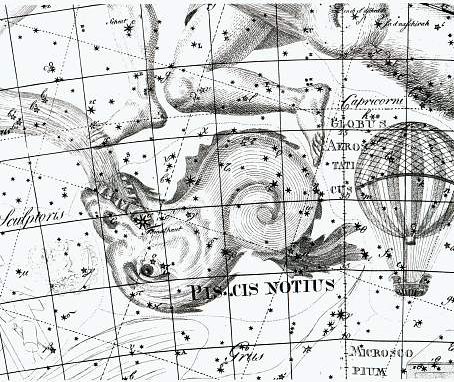 |
|
Febr 25
(421) |
26 (396 +
26) |
(31 + 27 =
58) |
28 (360 +
64) |
(360 + 65) |
(360 + 66) |
(360 + 67) |
|
p Carinae
(159.3) p
Carinae
(159.3) |
φ Hydrae
(160.3) |
No star
listed (161
→
φ) |
VATHORZ
POSTERIOR =
θ Carinae
(162.1),
PEREGRINI =
μ Velorum,
η Carinae
(162.6) |
ν Hydrae
(163.1) |
No star
listed (164)
ALTAIR (α
Aquilae) |
Wings-27
(Snake)
η
Octans
(165.4),
ALKES
(Shallow
Basin) =
α
Crateris
(165.6)
*124.0 =
*165.4 -
*41.4 |
|
Aug 27 (239) |
28 (422 -
182) |
29 (58 +
183) |
30 (242) |
31
|
Sept 1 |
2 (245) |
|
Corresponding
right
ascension
days in the
Golden Age
of the Bull: |
|
DEC 23 |
X-MAS EVE |
(359 = 423 -
64) |
26 (177 +
183) |
27 |
28 |
29 (363) |
|
JUNE 23 |
ST JOHN'S
DAY |
25 (176) |
26 (6 * 29½) |
27 |
28 |
29 (180) |
 |
 |
 |
 |
 |
 |
 |
|
Bb2-5 (36) |
(421 + 37 = 458) |
Bb2-7 |
Bb2-8 (460) |
Bb2-9 |
Bb2-10 (462) |
Bb2-11 (42) |
| e tagata moe mai |
ki te
marama etahi rua kokore |
ku ihi a mai - ki te
marama |
eaha te marama |
kua moe te goe ra |
ki te ika hiku raverave |
|
Ihi. 1. Line of singing women at a feast or
an êi. 2. Ihi, ihi-ihi, to break up into small
pieces, to crumble, to tear to pieces; he-ihi i te maúku, to
separate fibres. Vanaga. Ihiihi, to hop. Churchill.
Goe. Milky Way. Vanaga. |
|
FUM AL SAMAKAH (Mouth of the Fish) =
β
Piscium
(348.3),
ζ
Gruis (348.5),
ο
Andromedae (348.9) |
Al Fargh al Mukdim-24 (Fore Spout)
/
Purva Bhādrapadā-26 (First of the Blessed
Feet) /
House-13 (Pig)
SCHEAT
PEGASI = β
Pegasi,
π
Piscis Austrini (349.3),
κ
Gruis (349.4),
MARKAB
PEGASI = α
Pegasi
(349.5)
*308.0 = *349.4 - *41.4 |
23h (350.0 = 167.4 + 182.6)
υ, θ Gruis (350.0), π Cephei (350.6), ι Gruis (350.9)
|
SIMMAH = γ Piscium
(351.7) |
φ
Aquarii (352.0), ψ Aquarii (352.4), χ Aquarii (352.6), γ Tucanae
(352.8) |
ο
Cephei (353.3),
KERB (Bucket Rope) = τ Pegasi
(353.6) |
κ Piscium (354.2),
θ Piscium (354.4), υ Pegasi (354.9)
*313.0 = *354.4 - *41.4 |
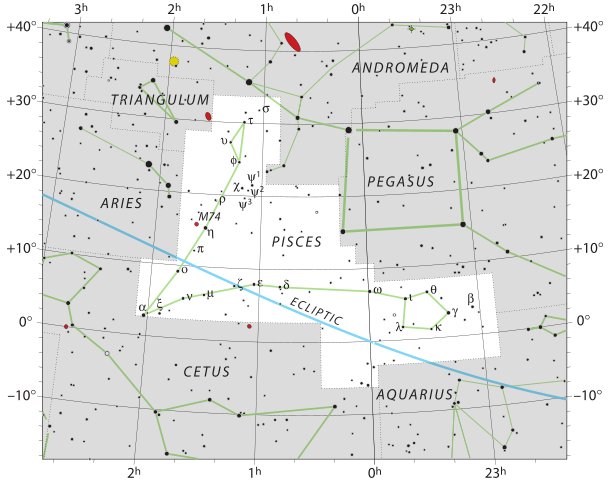 |
|
ANA-TIPU-4 (Upper-side-pillar - where the
guards stood)
MERAK (Loin, not Lion) =
β
Ursae Majoris
(166.2),
DUBHE (Bear) =
α
Ursae Majoris
(166.7) |
11h
(167.4)
χ
Leonis,
χ¹
Hydrae (167.1),
χ²
Hydrae (167.3)
*167.4 - *41.4 = *126.0 |
AL
SHARAS (The Ribs) =
β
Crateris
(168.6) |
Al Zubrah-9 (Mane) /
Purva Phalguni-11 (First Reddish One - Fig
Tree)
ZOSMA
(Girdle, not Belt) =
δ
Leonis
(169.2),
COXA
(Hips) = θ
Leonis (169.4)
*169.4 - *41.4 = *128.0 |
φ
Leonis (170.0),
ALULA
(First Spring of the Gazelle) =
ξ,
ν
Ursae Majoris
(170.5),
LABRUM =
δ
Crateris
(170.6) |
σ
Leonis (171.1),
λ
Crateris (171.6),
ι
Leonis,
ε
Crateris (171.9) |
γ
Crateris, π
Centauri (172.0),
κ
Crateris (172.5),
τ
Leonis (172.8)
GREDI (α Capricorni)
|
|
(364) |
(365) |
(459 - 29 - 64) |
(367 = 460 - 93) |
(368) |
(369) |
(370 = 354 + 16) |
|
(181) |
(365 - 183) |
(183) |
(184) |
(185) |
(186) |
(187 = 172 + 15) |
This pair of fishes opening their mouths (in order to be
refreshed) were side by side in the flow of days. However, the
first one was dead we can see, because an upside down fish must
surely have passed away.

The following one was in a better shape - and she had a male
companion:
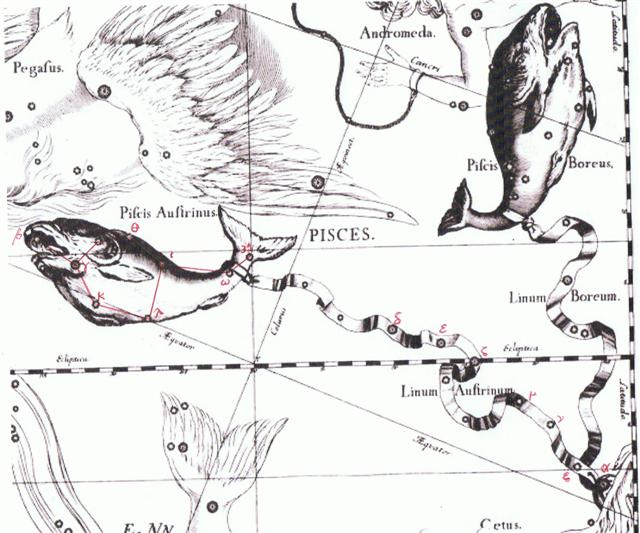
Fum al Samakah (β → female)
at the upper lip of the Southen Fish in Pisces came exactly a
day before the First Spout defined from β (Scheat)
Pegasi.
If we would turn the Southern Fish (Piscis
Austrini) half a cycle around she would then have her mouth oriented in the same way at
Piscis Notius (i.e. upside down and coming after her tail). She would
turn out to be
reversed, no longer representing the beginning but a terminal
position - sinisterly reversed.
When the ruling array of
constellations at the North Pole gradually had been forced away by
the precession of the Sun as revealed against the background of
the prominent stars

there had come a sudden jump in the
perspective when it became evident that the tip of the Ursa
Minor tail was
at the opposite side of the true pole than the rest of her:
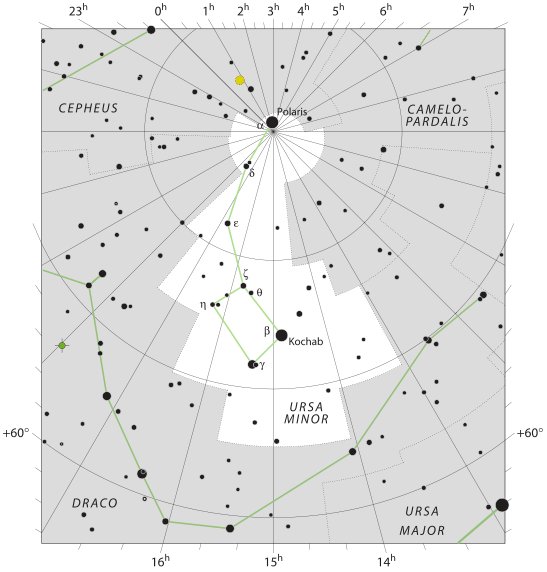
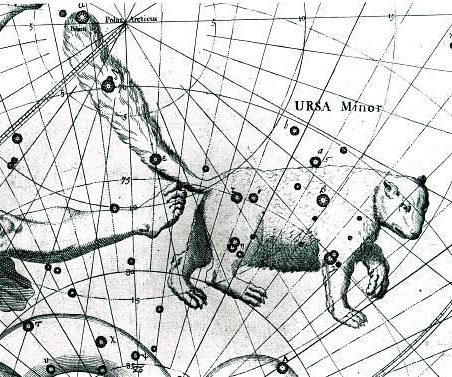
... This phenomenon is called the Precession
of the Equinoxes, and it was conceived as causing the rise and
the cataclysmic fall of ages of the world. Its cause is a bad
habit of the axis of our globe, which turns around in the manner
of a spinning top, its tip being in the center of our small
earth-ball, whence our earth axis, prolonged to the celestial
North Pole, describes a circle around the North Pole of the
ecliptic, the true 'center' of the planetary system, the radius
of this circle being of the same magnitude as the obliquity of
the ecliptic with respect to the equator: 23 ½º. The time which
this prolonged axis needs to circumscribe the ecliptical North
Pole is roughly 26,000 years, during which period it points to
one star after another: around 3000 B.C. the Pole star was alpha
Draconis; at the time of the Greeks it was beta Ursae Minoris;
for the time being it is alpha Ursae Minoris; in A.D. 14,000 it
will be Vega. The equinoxes, the points of intersection of
ecliptic and equator, swinging from the spinning axis of the
earth, move with the same speed of 26,000 years along the
ecliptic ...
I suggest the drastic change in
perspective regarding Ursa Minor - caused by changing from β
(female) to α (male) - forced a corresponding split up of
the preceding Piscis Notius
into the pair Piscis Austrinus and Piscis
Boreus, one beginning before 0h and the other after 0h. When
Kochab was dethroned Piscis
Notius was reversed and died. They both turned sinister.
This would explain the 3 dead 'limbs' (corresponding to winter
solstice and the pair of equinoxes) depicted in Bb1-31 - whereas
the bottom limb stood firm like the leg of a gyroscope:

... They walked in crowds when they arrived
at Tulan, and there was no fire. Only those with Tohil
had it: this was the tribe whose god was first to generate fire.
How it was generated is not clear. Their fire was already
burning when Jaguar Quitze and Jaguar Night first saw it: 'Alas!
Fire has not yet become ours. We'll die from the cold', they
said. And then Tohil spoke: 'Do not grieve. You will have your
own even when the fire you're talking about has been lost',
Tohil told them. 'Aren't you a true god! Our sustenance and our
support! Our god!' they said when they gave thanks for what
Tohil had said. 'Very well, in truth, I am your god: so be it. I
am your lord: so be it,' the penitents and sacrificers were told
by Tohil. And this was the warming of the tribes. They were
pleased by their fire. After that a great downpour began, which
cut short the fire of the tribes. And hail fell thickly on all
the tribes, and their fires were put out by the hail. Their
fires didn't start up again. So then Jaguar Quitze and Jaguar
Night asked for their fire again: 'Tohil, we'll be finished off
by the cold', they told Tohil. 'Well, do not grive', said Tohil.
Then he started a fire. He pivoted inside his sandal
...
The effects of the precession at
the bottom in the extrem southern part of the sky was hardly
noticed, because anciently there had been no obvious counterpart
to Vega at the pole in the north, and instead the root of the
tree corresponded to Crux in the Southern Cross:
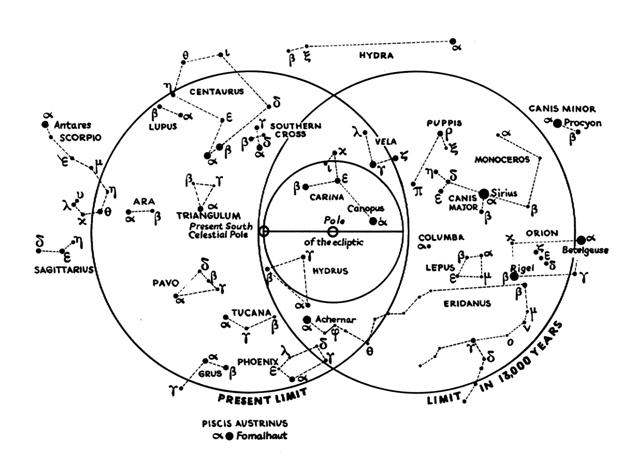
... Whittier said,
in his Cry of a Lost Soul: 'The Cross of pardon lights
the tropic skies'; which is correct for our day, as it is not
now entirely visible above 27º 30' of north latitude. It was
last seen on the horizon of Jerusalem - 31º 46' 45'' - about the
time that Christ was crucified. But 3000 years previously all
its stars were 7º above the horizon of the savages along the
shores of the Baltic Sea, in latitude 52º 30'
... Von
Humboldt adds: The two great stars, which marks the summit and
the foot of the Cross, having nearly the same right ascension,
it follows that the constellation is almost perpendicular at the
moment when it passes the meridian. This circumstance is known
to the people of every nation situated beyond the Tropics or in
the southern hemisphere. It has been observed at what hour of
the night, in different seasons, the Cross is erect or inclined.
It is a time piece, which advances very regularly nearly four
minutes a day, and no other group of stars affords to the naked
eye an observation of time so easily made. How often have we
heard our guides exclaim in the savannahs of Venezuela and in
the desert extending from Lima to Truxillo, 'Midnight is past,
the Cross begins to bend' ...
In the C text we have seen
Kochab at the Full Moon in the day
after the Sun had reached glyph number 407 (= 300 + 107),
and in the following night was autumn equinox according to
the era of Bharani:
 |
 |
 |
|
Cb1-12 (404 = 392
+ 12) |
Cb1-13 |
Cb1-14 |
|
manu rere - kua rere ga manu - ki
te ragi |
eaha te nuku erua |
koia kua huki |
|
CLOSE TO THE FULL
MOON: |
|
ρ Lupi (221.0),
TOLIMAN =
α Centauri
(221.2), π Bootis (221.8), ζ Bootis (221.9) |
31 Bootis
(222.0),
YANG MUN (South Gate) =
α
Lupi
(222.1),
RIJL AL AWWA (Foot of the Barker) =
μ
Virginis
(222.5),
ο
Bootis (222.9) |
IZAR (Girdle) =
ε
Bootis
(223.0),
109 Virginis,
α
Apodis (223.3),
μ
Librae (223.8) |
|
Oct 28 (301 = 118
+ 183) |
29 (420 - 118 =
302) |
30 (80 + 223 =
303) |
|
CLOSE TO THE SUN: |
|
April 28 (118 = 4
* 29½) |
29 (420 + 64 =
484 = 365 + 119) |
30 (120 = 80 +
40) |
|
ν Arietis (38.5), δ, ε Ceti (38.8) |
μ
Arietis (39.4), HEAD OF THE FLY = 35 Arietis
(39.6),
KAFFALJIDHMA (Part of a Hand) =
γ
Ceti,
θ
Persei (39.8)
*363.0
= *39.4 - *41.4 |
π
Ceti,
ο
Arietis (40.0),
ANGETENAR (Bend in the River) =
τ¹
Eridani,
μ Ceti (40.2),
RIGHT WING = 39 Arietis
(40.9) |
|
→ TERMINALIA |
FEBR 24 (365 + 55
= 420) |
25 (120 - 64 = 56) |
 |
 |
 |
|
Cb1-15 |
Cb1-16 (408) |
Cb1-17 |
|
e niu tu |
ki te ariki - e ka hua ra
tona rima |
koia kua iri i ruga o te rima
- e o to vaha mea |
|
CLOSE TO THE
FULL MOON: |
|
Al Zubānā-14a (Claws)
/
Visakha-16 (Forked)
/
Root-3 (Badger)
ZUBEN ELGENUBI (Southern Claw) =
α
Librae
(224.2),
ξ
Bootis,
ο
Lupi (224.5) |
KOCHAB (Kakkab) = β Ursae Min.
(225.0),
ξ Librae (225.7) |
KE KWAN (Cavalry Officer) =
β
Lupi
(226.3),
KE KWAN =
κ
Centauri (226.4), ZUBEN ELAKRIBI (Claw of the
Scorpion) =
δ
Librae
(226.8),
π¹
Oct.
(226.9)
*185.0 = *226.4 - *41.4 = "Sept 22 (265) =
equinox |
|
CLOSE TO THE SUN: |
|
May 1 (Beltane) |
2 (487 = 423
+ 64) |
3 (123 = 488
- 365) |
|
Bharani-2 (Yoni)
/
Stomach-17 (Pheasant)
π
Arietis (41.2),
MIRAM (Next to the Pleiades) = η Persei
(41.3),
BHARANI = 41 Arietis (41.4),
τ²
Eridani,
σ
Arietis (41.7) |
TA LING (Great Mound) = τ Persei (42.4)
*1.0 = *42.4 - *41.4 |
ρ
Arietis (43.0),
GORGONEA SECUNDA =
π
Persei
(43.5),
ACAMAR (End of the River) =
θ
Eridani
(43.6),
ε
Arietis (43.7),
λ
Ceti (43.9)
DENEBOLA (β Leonis) |
|
FEBR 26 (57) |
27 |
28 (424 = 365 + 59) |
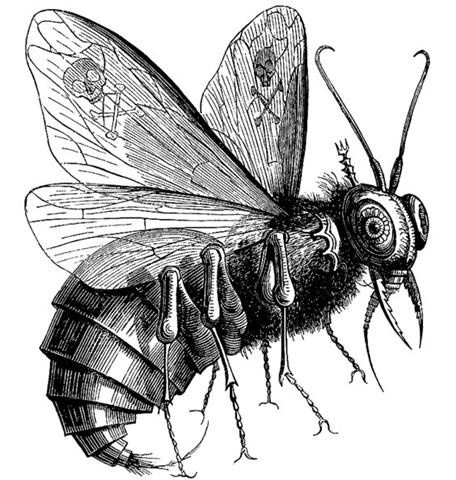
|






















